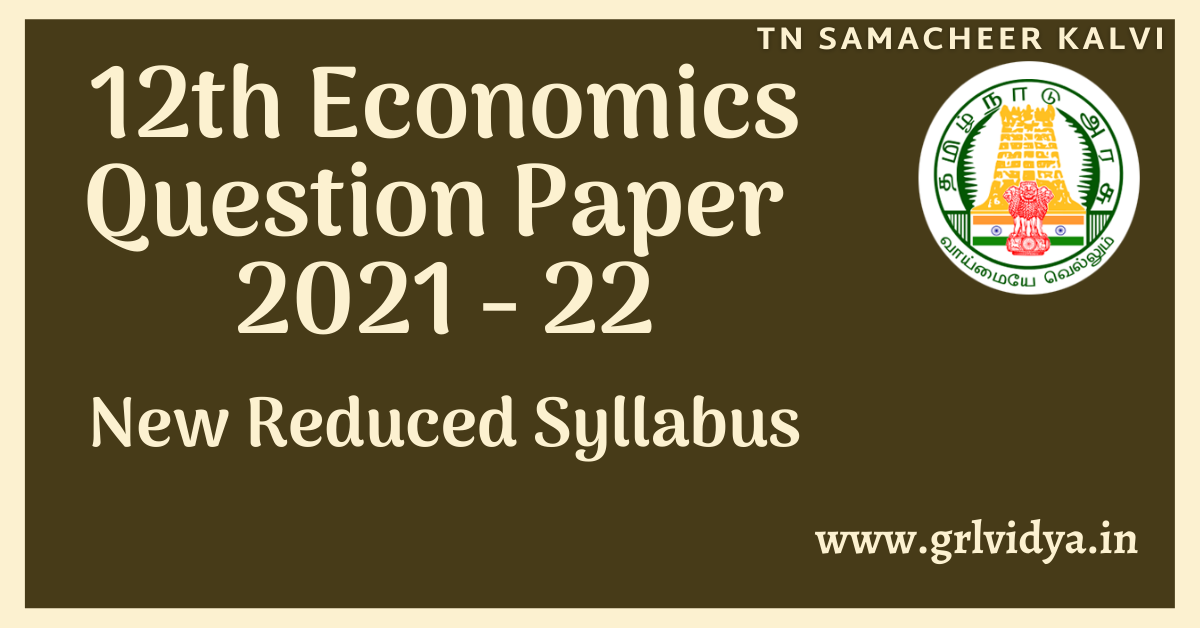CHENGALPATTU DISTRICT
SECOND ASSESSMENT TEST – 2022
12TH STANDARD ECONOMICS TIME : 3.00HRS Marks: 90
PART – I
I. Choose the correct answer (20×1=20)
1.Who coined the word ‘Macro’?
a) Adam Smith b) J M Keynes c) Ragnar Frisch d) Karl Marx
2. Macro economics is a study of ___________________.
a) individuals b) firms c) a nation d) aggregates
3. An economy consists of
a) consumption sector b) Production sector
c) Government sector d) All the above
4. Identify The Father of Socialism.
a) J M Keynes b) Karl Marx c) Adam Smith d) Samuelson
5. The Circular Flow Model that represents an open Economy.
a) Two Sector Model b) Three Sector Model c) Four Sector Model d) All the above
6. Income method is measured by summing up of all forms of ……………
(a) Revenue (b) Taxes (c) expenditure (d) Income
7. Tertiary sector is also called as ………. sector
(a) Service (b) Income (c) Industrial (d) Production
8. per capita income is obtained by dividing the National income by …………
(a) Production (b) Population of a country (c) Expenditure (d) GNP
9. The financial year in India is ……
(a) April 1 to March 31 (b) March 1 to April 30 (c) March 1 to March 16 (d) January 1 to December 31
10. The largest proportion of national income comes from …….
(a) Private sector (b) Local sector (c) Public sector (d) None of the above
11. In disguised unemployment, the marginal productivity of labour is …..
(a) Zero (b) One (c) Two (d) Positive
12. J.B. Say is a …………………….
(a) Neo-Classical Economist (b) Classical Economist (c) Modern Economist (d) New Economics
13. ………. Flexibility brings equality between saving and investment.
(a) Demand (b) Supply (c) Capital (d) Interes
14. Aggregate supply is equal to ………….
(a) C + I + G (b) C + S + G + (x-m) (c) C + S + T + (x-m) (d) C + S + T + R
15. Say’s law stressed the operation of …………. in the economy.
(a) Induced price mechanism (b) Automatic price mechanism (c) Induced demand (d) Induced investment
16. The average propensity to consume is measured by
(a) C/Y (b) CxY (c) Y/C (d) C+Y
17. Lower interest rates are likely to :
(a) Decrease in consumption (b) increase cost of borrowing (c) Encourage saving (d) increase borrowing and spending
18. The sum of the MPC and MPS is _______
(a)1 (b) 2 (c) 0.1 (d) 1.1
19. It the MPC is 0.5, the multiplier is ____________
(a) 2 (b)1/2 (c) 0.2 (d) 20
20. The term MEC was introduced by
(a) Adam Smith (b) J.M. Keynes (c) Ricardo (d) Malthu
PART -II
II. Answer any seven questions. Question No.30 is compulsory. (7 x 2 = 14)
21. Define Macro Economics.
22. ‘Circular Flow of Income’ – Define
23. Write the formula for calculating GNP
24. Define GDP deflator.
25. Define full employment.
26. Give reasons for labour retrenchment at present situation.
27. What is effective demand ?
28. What is consumption function?
29. Define marginal propensity to consume (MPC).
30. Define average propensity to save (APS)
PART – III
III. Answer any seven questions. Question No.40 is compulsory. (7 x 3 = 21)
31. State the importance of Macro Economics
32. Enumerate the features of mixed economy.
33. Briefly explain the two sector circular flow model.
34. Write a short note on per capita income.
35. Explain briefly NNP at factor cost.
36. What is the solution to the problem of double counting in the estimation of national
income?
37. Write short note on the implications of Say’s law.
38. What do you mean by aggregate demand ? Mention its components.
39. Differentiate autonomous and induced investment.
40. Mention the differences between accelerator and multiplier effect
PART – IV
IV. Answer all questions. (7 x 5 = 35)
41. (a) Compare the features of capitalism and socialism
(OR)
(b) Explain 3 sector circular flow model.
42. (a) Discuss the various methods of estimating the national income of a country.
(OR)
(b) i. Outline the major merits of capitalism.
ii. Indicate the demerits of socialism.
43. (a) Describe the types of unemployment.
(OR)
(b) Explain Keynes’ theory in the form of flow chart
44. (a) Critically explain Say’s law of market
(OR)
(b) i. What are the components of aggregate supply?
ii. Explain about aggregate supply with the help of diagram.
45. (a) Explain the operation of the Accelerator.
(OR)
(b) Explain consumption function with illustration.
46. (a) What are the differences between MEC and MEI
(OR)
(b) i. Define average propensity to consume (APC).
ii. What do you mean by propensity to save?
iii. Define Marginal Propensity to Save (MPS).
47. (a) Compare the feature among Capitalism, Secularism and Mixedism.
(OR)
(b) i. What are the merits of socialism?
ii. Write down the demerits of capitalism

